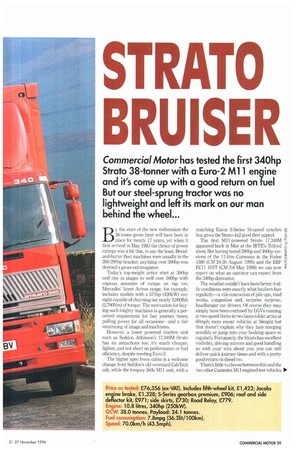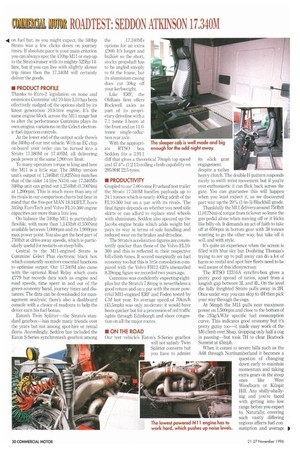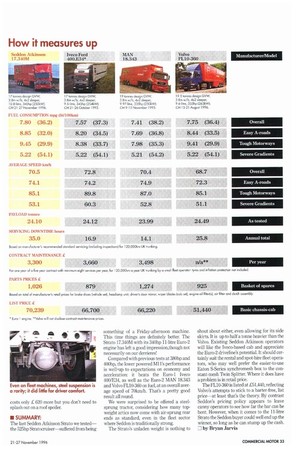STIZATO
Page 31

Page 32

Page 34

Page 35

If you've noticed an error in this article please click here to report it so we can fix it.
BRUISER By the start of the new millennium the 38-tonne gross limit will have been in place for nearly 17 years, yet when it first arrived in May 1983 the choice of power ratings was a bit thin, to say the least. Breadand-butter fleet machines were usually in the 260-290hp bracket; anything over 300hp was deemed a gross extravagance.
Today's top-weight artics start at 300hp and rise in stages to well over 500hp with copious amounts of torque on tap too. Mercedes' latest Actros range, for example, includes models with a 571bp (420kW) veeeight capable of churning out nearly 2,0001bit (2,700Nm) of torque. The motivation for buying such mighty machines is generally a perceived requirement for fast journey times, pulling power for all occasions—and a fair smattering of image and machismo.
However, a lower powered tractive unit such as Seddon Atkinson's 17.340M Strato has its attractions too: it's much cheaper, lighter, and not short on performance or fuel efficiency, despite meeting Euro-2.
The higher spec Iveco cabin is a welcome change from Seddon's old oversized CabTech cab, while the torquey little Mll unit, with a matching Eaton S-Series 16-speed synchro box gives the Strato 4x2 good fleet appeal.
The first M11-powered Strato 17.340M appeared back in May at the 1RTE's Telford
show. But having tested 380hp and 400hp versions of the 11-litre Cummins in the Foden 4380 (CM 24-30 August 1995) and the ER.F EC11 41ST (CM 2-8 May 1996) we can now report onon what an operator can expect from the 340hp derivative.
The weather couldn't have been better; traffic conditions were exactly what hauliers face regularly—a vile concoction of pile-ups, road works, congestion and, surprise surprise, headbanger car drivers. Of course they may simply have been confused by LGVs running at two speed limits in two lanes (older artics at 60mph; more recent vehicles at 56mph) but that doesn't explain why they hate merging sensibly or jump into your braking space so regularly. Fortunately the Strato has excellent visibility, driving mirrors and good handling so with your wits about you, you can still deliver quick journey times and with a pretty good return on diesel too.
There's little to choose between this and the two other Cummins Mll-engined test vehicles Po.
8
44 on fuel but, as you might expect, the 340hp Strato was a few clicks down on journey times. If absolute pace is your main criterion you can always spec the 410hp 1V11 1 or step up to the Stratocruiser with its mighty 525hp 14litre, but if you can live with slightly slower trip times then the 17.340M will certainly deliver the goods • PRODUCT PROFILE Thanks to Euro-2 legislation on noise and emissions Cummins' old 10-litre L10 has been effectively nudged off the options shelf by its latest generation 10.8-litre engine. It's the same engine block across the M11 range but to alter the performance Cummins plays its own enigma variations on the Celect electronic fuel-injection controls.
At the lower end of the output scale there's the 340hp of our test vehicle. With an EC chip on-board your order can be turned into a Strato 17.3801v1 or 17.405M, all delivering peak power at the same 1,900 rev limit.
To many operators torque is king and here the M11 is a little star. The 380hp version unit's output of 1,3461bft (1,825Nm) matches that of the older 14-litre N410; our 17.340M's 340hp unit can grind out 1,2541bft (1,700Nm) at 1,200rpm. This is much more than any of its rivals in our comparison charts but bear in mind that the five-pot MAN 18.343FLT, Iveco 345hp EuroTech and Volvo FL10-360 engine capacities are more than a litre less.
On balance the 340hp Mll is particularly flexible, with more than 1,1431bft (1,550Nm) available between 1,000rpm and its 1,900rpm max power point. You also get the best part of 7501bft at drive-away speeds, which is particularly useful for restarts on steep hills.
Central to the M1 1-engined Strato is Cummins' Celect Plus electronic black box which constantly monitors essential functions to optimise output. Our 17.340M also came with the optional Road Relay which costs ,,t779 but records data such as engine and road speeds, time spent in and out of the green economy band, journey times and distances. The data can be downloaded for management analysis; there's also a dashboard console with a choice of readouts to help the driver earn his fuel bonus.
Eaton's Twin Splitter—the Strato's standard gearbox—has made many friends over the years but not among spot-hire or rental fleets. Accordingly, Seddon has included the Eaton S-Series synchromesh gearbox among the 17.340M's options for an extra £900. It's longer and bulkier so the short, stocky propshaft has to be angled steeply to fit the frame, but its aluminium casing does cut 30kg off your kerbweight.
Like ERF, the Oldham firm offers Rockwell axles as part of its proprietary driveline with a 7,1 tonne 1-beam at the front and an 11.0tonne single-reduction rear axle.
With the appropriate RTSO box Seddon fits a 3.91:1 diff that gives a theoretical 70inpli top speed and 47.4% (1:2.11) rolling climb capability on 295/80R 22.5 tyres.
Coupled to our 7.00-tonne Fruehauf test trailer the Strato 17.340M handles payloads up to 24.1 tonnes which is nearly 400kg adrift of the FL10-360 but on a par with its rivals. The final figure depends on whether you need side skirts or can afford to replace steel wheels with aluminium. Seddon also specced up the Jacobs engine brake which adds weight but pays its way in terms of safe handling and reduced wear on the brakes and clriveline.
The Strato's acceleration figures are consistently quicker than those of the Volvo ELIO360 and this is reflected in their respective hill-climb times. It scored marginally on fuel economy too but this is little consolation compared with the Volvo FH12-420's unexcelled 8.39inpg figure we recorded two years ago.
Cummins was confidently expecting eightplus but the Stators 7.8mpg is nevertheless a good return and on a par with the more powerful M11-engined ERF and Foden tested by CM last year. Its average speed of 70km/h (43,5mph) was only moderate: it would have been quicker but for a procession of red traffic lights through Edinburgh and sheer congestion on all the major routes. its slick gear engagement despite a rather heavy clutch. The double-H pattern responds nicely to swift wrist movement but if you're over-enthusiastic it can flick back across the gate. You can guarantee this will happen when you least expect it, as we discovered part way up the 20% (1-in-5) Blackhill grade.
Thankfully the M11 delivers around 7501bft (1,017Nm) of torque from tickover so leave the gas pedal alone when moving off or it kicks like billy-oh. It demands an act of faith to take off at 650rpm in bottom gear with 38 tonnes wanting to go the other way, but take off it will, and with style.
It's quite an experience when the screen is filled with blue sky but Doubting Thomas's trying to rev up to pull away can do a lot of harm so rental and spot hire fleets need to be well aware of this idiosyncrasy.
The RTSO 12316A synchro-box gives a pretty good spread of ratios, apart from a longish gap between 3L and 4L. On the level the fully freighted Strato pulls away in 2H. Once under way you can skip to 4H then pick your way through the cogs.
At 56mph the Mll pulls near maximum power on 1,500rpm and close to the bottom of the 193g/kWhr specific fuel consumption curve. This indicates good economy but it's pretty gutsy too—it made easy work of the M6 climb over Shap, dropping only half a cog in passing—but took 7H to clear Beattock Summit at 45mph.
When it comes to severe hills such as the A68 through Northumberland it becomes a question of changing down early to maintain momentum and taking extra gears on the steep ones like West Woodburn or Kilnpit Hill. Any shilly-shallying and you're faced with getting into low range before you expect to. Naturally, covering such vastly differing regions affects fuel consumption and average
44 speeds but with Road Relay there's a steady flow of information on tap to encourage the driver to appreciate its performance.
On major routes the optional Cruise Control is a useful aid to maintaining maximum or selected speeds and combines most comfortably with the Jake brake to keep the outfit in check. Descending hills like the southern side of Carter Bar or the B6278 down to Shotley Bridge underlines the value of such a retarder, particularly when control speed is reached. Here the Strato's excellent brakes become largely redundant.
It reinforces our view that if the authorities are serious about improving road safety then operators should be given inducements to invest in retarders.
A minor whinge is the positioning of the Jake Brake's two small switches behind the gearlever where they may be kicked or flicked. There are sufficient spare slots on the dash or, better still, a steering column switch might be used.
The majority of tractive units have air suspension these days so we were surprised to find the Strato with steel springs all round. We weren't allowed to forget it either as it delivered a hard, bouncy ride for most of the three days, particularly on urban streets. This was offset by the air-sprung driver's seat but even on the Al(M) and M18 it see-sawed away on the older sections.
One of the benefits of Iveco ownership is the availability of more modern cabs including models designed for municipal work.
We weren't too impressed by some aspects of the cab on the pre-production Stratocruiser we tested back in the summer (CM 1-7 August), but the 17.340M cab's fixtures and fittings are well put together and, apart from a pulsing rev counter, everything functioned correctly.
The 340hp Mll is quite the noisiest of the three Cummins 11-litre lumps we've encountered, recording 77dB(A) at the 901crn/h limit Clearly it was working harder.
Cab access is easy and with the seat and steering wheel adjusted to suit, switches and controls are well within easy reach. This is also a fairly roomy cab with good space in the driver's footwell and adequate storage under the bunk. There are also door pockets and two trays between the seats but not a great deal of secure space for those important documents.
The deep screen and angular A-posts ensure good forward visibility while longrange mirrors cut down on blind spots. Cyclists are a hazard but there's a large kerb mirror and extra glass in the nearside door to avoid problems (many drivers tend to blank off this glass to keep the light out or for security reasons).
For regular nights away the standard Strato sleeper has its limitations. Changing clothes is difficult under its low ceiling and the standing space on the passenger side is awkward. Once in your sleeping bag the bunk area is spacious enough but Iveco has skimped on a 56mm deep palliasse.
If driver welfare means anything, insist on a double mattress and a high-roof sleeper. It
something of a Friday-afternoon machine. This time things are definitely better. The Strato 17.340M with its 340hp 11-litre Euro-2 engine has left a good impression,though not necessarily on our derrieres!
Compared with previous tests at 380hp and 400hp, the lower powered M1 l's performance is well,up to expectations on economy and acceleration: it beats the Euro-1 Iveco 400/E34, as well as the Euro-2 MAN 18.343 and Volvo FL10-360on fuel, at an overall average speed of 70km/h. That's a pretty good result all round.
We were surprised to be offered a steelsprung tractor, considering how many topweight artics now come with air-sprung rear ends as standard, even in the fleet sector where Seddon is traditionally strong.
The Strato's unladen weight is nothing to shout about either, even allowing for its side skirts. It is up to half a tonne heavier than the Volvo. Existing Seddon Atkinson operators will like the Iveco-based cab and appreciate the Euro-2 driveline's potential. It should certainly suit the rental and spot-hire fleet operators, who may well prefer the easier-to-use Eaton S-Series synchromesh box to the constant-mesh Twin Splitter. Where it does have a problem is in retail price.
The FL10-360 is listed at £51,440, reflecting Volvo's attempts to stick to a barter-free, list price-at least that the theory. BY contrast Seddon's pricing policy appears to leave canny operators to see how far the bar can be bent. However, when it comes to the 11-litre Strato the Seddon buyer could well end up the winner, so long as he can stump up the cash.
by Bryan Jarvis




















































































































































































































